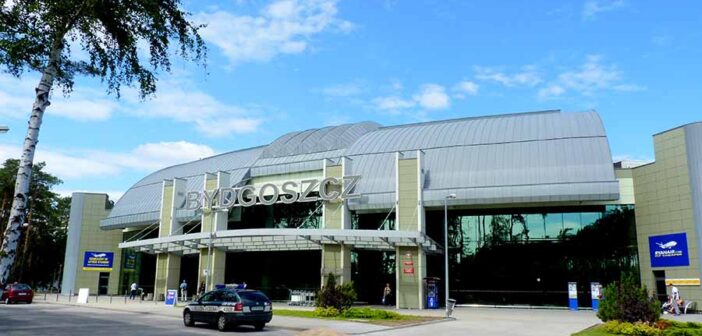
Bydgoszcz Ignacy Jan Paderewski Airport (BZG), located just 3.5 kilometres from the city centre, serves as a convenient regional hub for travellers in northern Poland, handling around 413,245 passengers in 2018. With a single terminal and flights to nine destinations operated by airlines like Ryanair, LOT, and Lufthansa, the airport provides a straightforward experience for those travelling to cities such as Warsaw, Frankfurt, and Birmingham. Its compact size and modern facilities make it an appealing choice for passengers seeking a hassle-free journey.
Accessing the airport is simple, with several transport options connecting to Bydgoszcz’s city centre. Bus line 80 operates daily between the airport and the railway station, covering the distance in approximately 15 minutes for a fare of about €1. Tickets are available at the terminal’s newsstand or on the bus.
Taxis, stationed on the right side of the terminal, offer a quick 10-minute ride to the city centre for around €10 to €15, depending on traffic. For those driving, a car park with 258 spaces is available, free for the first 10 minutes and costing €41 for a week, with clear signage guiding drivers to the entrance. Car rental agencies, including Avis, Hertz, and Enterprise, are located in the arrivals hall. Passengers are advised to arrive two hours before domestic flights and three hours before international departures to account for check-in and security.
The airport’s single-terminal layout is easy to navigate, with two entrances leading to a central area housing 31 check-in desks opposite the main entrance. Arrivals and departures are on the ground floor, with the departures hall on the first floor accessible via stairs or lifts. The terminal splits into Schengen and non-Schengen zones, and clear signage ensures quick movement, with walking times under five minutes.
Security and passport control are generally efficient, but peak summer periods or holiday seasons can lead to longer queues due to increased passenger traffic. Baggage claim delays, occasionally caused by limited carousels or staffing issues, may also occur, so passengers should check flight statuses via the airport’s website or in-terminal displays.
Dining and retail options are modest but sufficient for a small airport. The So Coffee shop on the first floor offers snacks and beverages, while vending machines in the arrivals hall provide quick bites. Baltona Duty-Free, located on the first floor for Schengen flights and ground floor for non-Schengen, operates from 8:00 am to 4:00 pm Monday to Saturday, stocking travel essentials and local souvenirs. Prices are slightly higher than city averages, with a coffee costing around €2.50. The Burgas Airport Lounge near Gate 1 provides Wi-Fi, snacks, and seating for €28, accessible via Priority Pass. Passengers note that dining options can feel limited during peak times, so grabbing food before security is advisable.
Facilities cater to essential traveller needs, with free Wi-Fi available throughout the terminal. Charging stations are limited, and seating is mostly rigid, with few padded chairs. Accessibility is well-supported, with ramps, lifts, and mother-and-child rooms in the main terminal and departures hall. A currency exchange office and ATM are located on the ground floor, alongside an information desk for assistance. No luggage storage is available, but baggage wrapping services are offered. Nearby hotels, such as the Hotel Brda, a 10-minute drive away, provide convenient accommodation with shuttle options. For smokers, designated areas are available outside the terminal.
On-time performance is generally reliable, with the airport’s smaller size reducing congestion-related delays. Disruptions are typically due to airline-specific issues, such as equipment problems, or weather conditions, particularly in winter. Passengers can stay updated via Flightradar24 or the airport’s displays. As a regional airport, Bydgoszcz focuses on direct flights, with limited connecting options. LOT’s route to Warsaw offers connections to larger hubs, with a minimum connection time of 45 minutes. The single-terminal setup simplifies transfers, but non-Schengen passengers may face delays at passport control during busy periods. Those on separate tickets should verify luggage transfer policies to avoid rechecking bags.
Bydgoszcz Airport’s compact design, proximity to the city, and essential amenities make it a practical choice for regional travellers. Ongoing improvements, such as taxiway upgrades and general aviation services, aim to enhance passenger comfort. While limited dining and seating may pose challenges during peak times, the airport’s accessibility and efficiency ensure a pleasant experience for those travelling through northern Poland. Non-EU/EEA passengers may need visa checks
Ryanair
Ryanair operates flights to Dublin on Wednesdays and Sundays, operating from the main terminal, with check-in desks typically in the check-in area (desks 1–5). Exact desk numbers are displayed on airport screens.
Flights to Ireland (Dublin) typically depart from Schengen gates (gates 1–3). Gates are assigned dynamically and shown on departure boards. As a smaller airport, facilities and gate assignments are limited.




